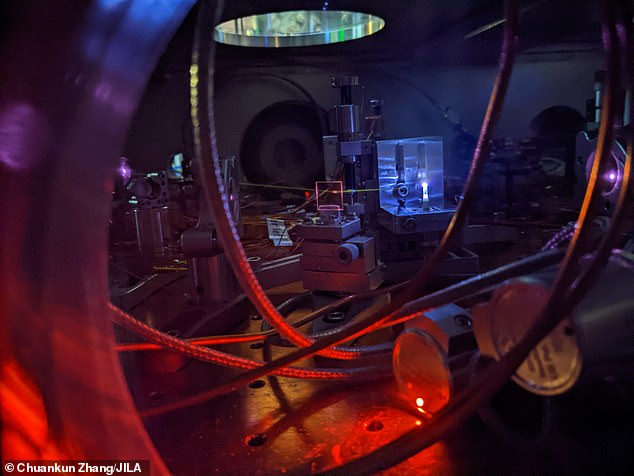Forget the atomic clock! World’s first NUCLEAR clock unveiled – paving the way for ultra-precise timekeeping
For decades, the world has been kept track of by the ticking of atomic clocks.
But they may soon be a thing of the past thanks to the advent of a nuclear clock, which could revolutionize the way we measure time.
An international team has demonstrated the key elements of the device, paving the way for extremely accurate timekeeping.
The clock works using signals from the nucleus of an atom.
The team used a specially designed ultraviolet laser to precisely measure the frequency of an energy jump in the nuclei of thorium – a naturally occurring metal – in a solid crystal.
For decades, the world has kept track of time by the ticking of atomic clocks. But they could soon be a thing of the past, thanks to the introduction of a nuclear clock (artist impression) that could revolutionize the way we measure time
They also used an optical frequency comb, which acts as an extremely precise light ruler, to count the number of ultraviolet wave cycles that cause this energy jump.
This transition from one similar energy state to another – which occurs very quickly – allows measurements to be made with high accuracy.
While this laboratory demonstration is not a fully developed nuclear clock, it does contain all the basic technology for one, the researchers say.
Nuclear clocks could be much more accurate than today’s atomic clocks, which keep official international time and play an important role in technologies such as GPS, Internet synchronization and financial transactions.
For the general public, this development could ultimately lead to even more accurate navigation systems, faster internet, more reliable network connections and more secure digital communications.
In addition to everyday technology, nuclear clocks could also improve tests of fundamental theories about how the universe works, potentially leading to new discoveries in physics.
They could help detect dark matter or verify whether the constants of nature are really constant. This would allow theories in particle physics to be verified without the need for large-scale particle accelerators.

The team used a specially designed ultraviolet laser to precisely measure the frequency of an energy jump in the nuclei of thorium – a naturally occurring metal – in a solid crystal
According to the researchers, a nuclear clock would have major advantages in terms of clock accuracy compared to current technology.
Atomic clocks measure time by tuning laser light to frequencies that cause electrons to jump between energy levels.
However, compared to the electrons in atomic clocks, the mechanisms in a nuclear clock are much less affected by external disturbances, such as stray electromagnetic fields.
In addition, the laser light used in a nuclear clock has a much higher frequency than that of atomic clocks.
This results in more ‘ticks’ per second and therefore more accurate timekeeping.
The team included researchers from the National Institute of Standards and Technology in Maryland and the University of Colorado Boulder.
Jun Ye, one of the study’s authors, said: ‘Imagine a wristwatch that would not lose a single second, even if you left it running for billions of years.
“While we’re not quite there yet, this research brings us closer to that level of precision.”
Thorsten Schumm, another author, said: ‘With this first prototype we have proven that thorium can be used as a timekeeper for very high precision measurements.
“The only thing left is the technical development work. No major obstacles are expected.”
The findings are published in the journal Nature.
